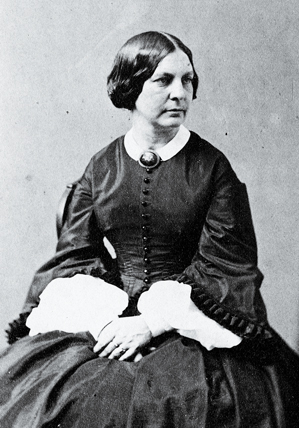More than 60 people gathered in McCormick Hall on May 13 to celebrate an exceptional MIT institution. Although few of them had earned a degree, taught, or worked at MIT, they share a strong connection to the Institute. As widows and widowers of MIT faculty and alumni, they are all members of the Emma Rogers Society, which marked its 25th anniversary at that luncheon.

The group is named for Emma Savage Rogers (1824–1911), the daughter of a wealthy Boston banker and businessman, who married MIT’s founder, William Barton Rogers, in 1849. Known for her intellect and vitality, she supported Rogers tirelessly as his health began to fail, often acting as an intermediary with faculty and colleagues.
After President Rogers died during commencement ceremonies in 1882, Emma continued to be a valued advisor to four MIT presidents and generously opened her home and her heart to students, teachers, and alumni until her death in 1911.
In 1989, inspired by Emma Rogers and many other examples of spouses with deep commitments to MIT, President Paul Gray ’54, SM ’55, ScD ’60, and his wife, Priscilla, began working with the Institute’s vice president and treasurer, Glenn Strehle ’58, SM ’60, to find a way to formally address the needs of people whose MIT-affiliated husbands and wives had died. ERS was launched in 1990 to make widows of alumni and faculty feel welcome on campus and keep them connected to the Institute.
“MIT has always been like a big family in so many ways, and surviving spouses are just as important to that family as they were in earlier years,” says Priscilla Gray.
After Charles M. Vest became president of MIT in 1990, his wife, Rebecca M. Vest, was honorary chair of ERS for many years, often hosting activities at Gray House. When her husband passed away in 2013, she became a member herself.
Today, there are more than 5,000 members of the Emma Rogers Society around the globe. The group gathers at Tech Reunions in June and meets in the Boston area three to five times a year for luncheon lectures, on or off campus.
Besides keeping up with MIT research, group members also support one another. “The group does not formally talk about grieving and loss, but there is great comfort in knowing that everyone in the room knows what it is like to be missing a spouse, whether it’s been a few months or many years,” says Ann Allen, a longtime member of the group whose husband, Professor Jonathan Allen, PhD ’68, passed away in 2000. “Many good and important conversations happen over lunch and often continue in the parking lot and beyond.”
Benefits of the program flow both ways. ERS members may participate in the life of the Institute community, including the MIT Alumni Travel program and events open to alumni on campus. Though they are not actively solicited for donations, surviving spouses contribute millions of dollars to MIT each year. Others form relationships with faculty members and academic departments by volunteering, attending lectures, and participating as subjects in studies about memory and aging.
For more information about the Emma Rogers Society and to learn about upcoming events, call 617-253-8059 or write to ers@mit.edu.
Keep Reading
Most Popular
Large language models can do jaw-dropping things. But nobody knows exactly why.
And that's a problem. Figuring it out is one of the biggest scientific puzzles of our time and a crucial step towards controlling more powerful future models.
The problem with plug-in hybrids? Their drivers.
Plug-in hybrids are often sold as a transition to EVs, but new data from Europe shows we’re still underestimating the emissions they produce.
Google DeepMind’s new generative model makes Super Mario–like games from scratch
Genie learns how to control games by watching hours and hours of video. It could help train next-gen robots too.
How scientists traced a mysterious covid case back to six toilets
When wastewater surveillance turns into a hunt for a single infected individual, the ethics get tricky.
Stay connected
Get the latest updates from
MIT Technology Review
Discover special offers, top stories, upcoming events, and more.